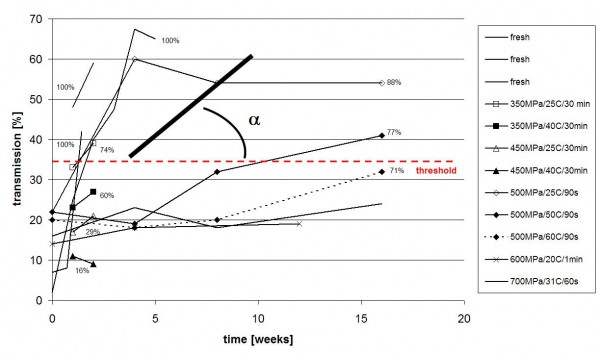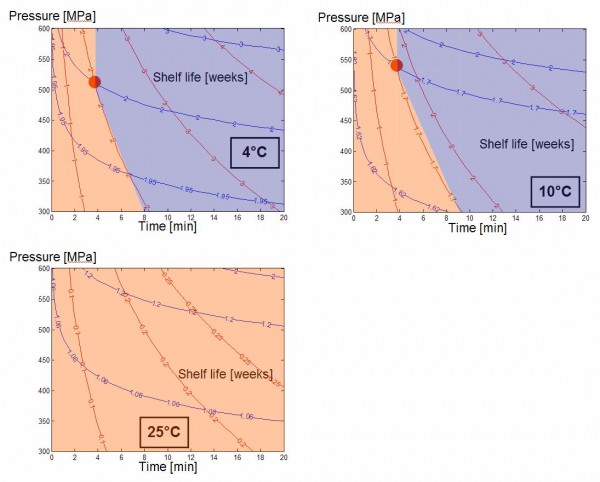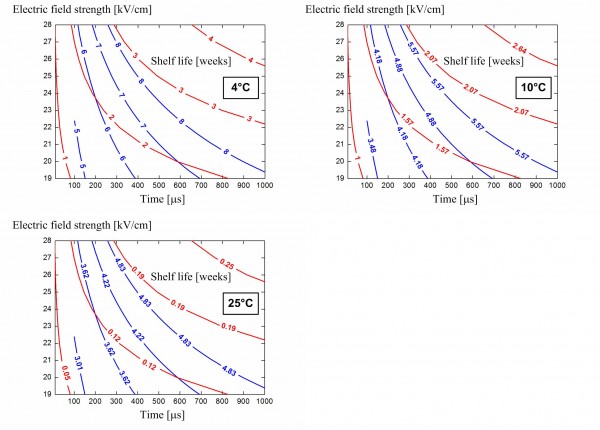Predictive shelf life modelling of orange juice treated by novel processing
- Like
- Digg
- Del
- Tumblr
- VKontakte
- Buffer
- Love This
- Odnoklassniki
- Meneame
- Blogger
- Amazon
- Yahoo Mail
- Gmail
- AOL
- Newsvine
- HackerNews
- Evernote
- MySpace
- Mail.ru
- Viadeo
- Line
- Comments
- Yummly
- SMS
- Viber
- Telegram
- Subscribe
- Skype
- Facebook Messenger
- Kakao
- LiveJournal
- Yammer
- Edgar
- Fintel
- Mix
- Instapaper
- Copy Link
Posted: 4 November 2010 | Floor Boon, TNO and Nicolas Meneses & Dietrich Knorr, Technische Universität Berlin | 1 comment
Shelf life is defined as the period during which a product is acceptable for human consumption. Products are spoiled by microbial, chemical and physical processes. Shelf life is determined by the raw material quality, product formulation, processing, packaging and storage conditions. Processes that determine shelf life can be described using mathematical models, which can be used to predict shelf life or determine preservation conditions to achieve a desired shelf life. In this article, a predictive shelf life model for orange juice treated by high pressure (HP) and pulsed electric field (PEF) processing is described. Shelf life is based on microbial and enzymatic spoilage.
Shelf life is defined as the period during which a product is acceptable for human consumption. Products are spoiled by microbial, chemical and physical processes. Shelf life is determined by the raw material quality, product formulation, processing, packaging and storage conditions. Processes that determine shelf life can be described using mathematical models, which can be used to predict shelf life or determine preservation conditions to achieve a desired shelf life. In this article, a predictive shelf life model for orange juice treated by high pressure (HP) and pulsed electric field (PEF) processing is described. Shelf life is based on microbial and enzymatic spoilage.
Shelf life is defined as the period during which a product is acceptable for human consumption. Products are spoiled by microbial, chemical and physical processes. Shelf life is determined by the raw material quality, product formulation, processing, packaging and storage conditions. Processes that determine shelf life can be described using mathematical models, which can be used to predict shelf life or determine preservation conditions to achieve a desired shelf life. In this article, a predictive shelf life model for orange juice treated by high pressure (HP) and pulsed electric field (PEF) processing is described. Shelf life is based on microbial and enzymatic spoilage. Orange juice is an acidic product with a pH of approximately 3.5 at which spore-forming bacteria cannot grow and pasteurisation is sufficient to obtain a microbially-stable product. The initial microbial population of orange juice ranges from 4 to 8 log cfu/ml. In the model, 5 log cfu/mL was assumed and the juice accepted for human consumption up to 6 log cfu/mL1. For microbial growth, a doubling time of 24 hours at 4°C was assumed, resulting in a shelf life of four days for fresh juice. An activation energy of 120 kJ/mol2 was used to describe the yeast growth at various storage temperatures. Besides spoilage, it is important to guarantee a microbially-safe food product. Listeria monocytogenes is considered to be the most important target micro-organism. There is no agreement concerning a mathematical model that accurately describes the inactivation kinetics of micro-organisms using the combined effects of temperature and pressure. The main problem is a lack of understanding of the basic underlying physical mechanism of inactivation. The first-order model of Dogan and Erkmen3, describing inactivation of Listeria monocytogenes in orange juice as a consequence of high pressure (300-600 MPa) at 25°C, was used to predict the microbial spoilage in orange juice. It is generally accepted that the main inactivation mechanism of micro-organisms with PEF treatment is electroporation of the cell membrane. This is dependent on product conductivity and pH4. There is no model describing the combined effect of PEF and temperature. The three models most commonly used to describe inactivation kinetics as a function of the electric field strength and treatment time are the Hülsheger model, the Peleg model and Weibull distribution. These models are empirical since theoretical models for the PEF inactivation mechanism have not yet been coupled to inactivation kinetics. The Weibull model from Gomez et al.4, describing Listeria monocytoges inactivation in a buffer (pH 3.5 – 7.0) with a conductivity of 2 mS/cm at electric field strengths between 15 and 29 kV/cm, and treatment times between 100 and 1500μs was used in the shelf life model (pH 3.5); checked against the predictive capability of the model with measurements in apple juice, the results were in close agreement.


Figure 1 Cloud loss in orange juice during storage at 4°C 6,9-12
Predicting enzymatic shelf life
Enzyme activity in food may result in a change in the chemical composition of the product, altering flavour, odour, colour and texture. Reactions where enzymes have a role in food are oxidation, browning, texture loss and ripening. The enzyme pectinmethylesterase (PME) was chosen as the target enzyme in orange juice because its affect on quality aspects such as cloud stability is well known. In the literature, models were found describing the inactivation of PME in orange juice by the combined effects of temperature and pressure5,6. Enzyme activity depends strongly on the matrix, and therefore models based on data from purified enzymes in buffers cannot be used for shelf life. The models described by Polydera et al.5 and Nienaber and Shellhammer6 were based on first-order fractional conversion and the Arrhenius and Eyring equation. The model of Polydera et al.5 was selected to predict shelf life because it describes the combined affects of temperature (40 – 60°C) and pressure (400 – 800 MPa) on PME inactivation for any arbitrary combination. Many publications were found describing the impact of PEF treatment on PME inactivation in orange juice. Only Elez-Martinez et al.7, however, developed a kinetic inactivation model for PME and a model based on Fermi’s model was used for shelf life. Yeom et al.8 confirmed the combined effects of temperature and PEF. However, in this model, the effect of temperature on PME inactivation was not taken into account.


Figure 1 Cloud loss in orange juice during storage at 4°C 6,9-12
Processing inactivates enzymes to a certain degree; product formulation and storage condition determine the activity of the enzyme and as a result, the rate of degradation during further storage. Initial enzyme activities in fruit juices are difficult to compare because the enzyme activity is proportional to the pulp content of the juice (often not mentioned) and because different measuring methods result in different magnitudes of activity. For the shelf life model, PME rest activity was related to cloudloss during storage (see box). Transmission above 36 per cent was defined as cloud-loss and ‘off-spec’6,9,10.
Predicting the shelf life of orange juice
Shelf life models for microbial and enzymatic spoilage were combined in such a way that, for each process setting (within the boundaries of the model), the shelf life of orange juice could be predicted. For some process settings, microbial deterioration was dominant; for others it was enzymatic deterioration. The results are given in Figure 2 on page 76 for HP treatment and in Figure 3 for PEF treatment. For HP treated orange juice, it was shown that at low storage temperatures (4 – 10°C) and longer processing times (for 300 – 500 MPa, longer than eight minutes and for 500 MPa, longer than five minutes), enzymatic spoilage determined shelf life. For short processing times and storage at elevated temperatures (25°C), microbial spoilage became more dominant. For PEF treated orange juice, microbial spoilage always determined the shelf life (in a range between 19 – 28 kV/cm and 10 – 1000 μs); similar values for shelf life based on yeast (four weeks) were found by Elez-Martínez et al.13.


Figure 3 Shelf life (weeks) of orange juice based on microbial (red) and enzymatic (blue) spoilage as a function of electric field strength (kV/cm) and process time (μs)
Conclusions
A shelf life model for PEF and HP treated orange juice was developed using data from the literature and insights from NovelQ. The model can be applied to predict shelf life based upon microbial and enzymatic spoilage, and determination of processing conditions to obtain a desired shelf life. The model combines microbial inactivation and growth with enzyme inactivation, enzyme rest activity and quality.
References
1. Raccach M, Mellatdoust M. 2007. The effect of temperature on microbial growth in orange juice. Journal of Food Processing and Preservation 31(2): 129-142 2. Zanoni B, Pagliarini E, Galli A, Laureati M. 2005. Shelf life prediction of fresh blood orange juice. Journal of Food Engineering 70(4): 512-517 3. Dogan C, Erkman O. 2004. High pressure inactivation kinetics of Listeria monocytogenes inactivation in broth, milk, and peach and orange juices. Journal of Food Engineering 62: 47-52. 4. Gómez N, García D, Álvarez I, Condón S, Raso J. 2005. Modelling inactivation of Listeria monocytogenes by pulsed electric fields in media of different pH. International Journal of Food Microbiology 103(2): 199-206 5. Polydera AC, Galanou E, Stoforos NG, Taoukis PS. 2004. Inactivation kinetic of pectin methylesterase of Greek navel orange juices as a function of high hydrostatic pressure and temperature process conditions. Journal of Food Engineering 62: 291-298 6. Nienaber U, Shellhammer TH. 2001. High-pressure processing of orange juice: combination treatments and shelf life study. Food Engineering and Physical Properties 66(2): 332-336 7. Elez-Martínez P, Suárez-Recio M, Martín-Belloso O. 2007. Modelling the reduction of pectin methyl esterase activity in orange juice by high intensity pulsed electric fields. Journal of Food Engineering 78(1): 184-193 8. Yeom HW, Zhang QH, Chism GW. 2002. Inactivation of pectin methyl esterase in orange juice by pulsed electric fields. Journal of Food Science 67(6): 2154-2159 9. Parish ME. 1998. Orange juice quality after treatment by thermal pasteurization or isostatic high pressure. Lebensmittel Wissenschaft und Technologie, 31: 439-442 10. Goodner JK, Braddock RJ, Parish ME, Sims CA. 1999. Cloud stabilization of orange juice by high pressure processing. Journal of Food Science 64(4): 699-700 11. Bayindirli A, Alpas H, Bozoglu F, Hizal M. 2006. Efficiency of high pressure treatment on inactivation of pathogenic micro-organisms and enzymes in apple, orange, apricot and sour cherry juices. Food Control 17: 52-58 12. Bull MK, Szabo EA, Cole MB, Stewart CM. 2004. Towards validation of process criteria for high-pressure processing of orange juice with predictive models. Journal of Food Protection 68(5): 949-954 13. Elez-Martínez P, Soliva-Fortuny RC, Martín-Belloso O. 2006. Comparative study on shelf life of orange juice processed by high intensity pulsed electric fields or heat treatment. European Food Research and Technology 222(3-4): 321-329
About the Authors
Floor Boon
Floor is a researcher at TNO in the field of processes for the agro-food industry in general. She holds specific knowledge on modelling of thermal processes, food quality and affinity separation processes. In this field, she has carried out numerous contract research projects. She completed her PhD at Wageningen University in the field of food processing.
Dietrich Knorr
Dietrich is Professor, Director of the Institute of Food Technology and Food Chemistry since 2001 and Head of the Department of Food Biotechnology and Food Process Engineering at Technische Universität Berlin since 1987. He is Editor of the Journal of Innovative Food Science and Emerging Technologies, Research Professor at the University of Delaware, USA and Adjunct Professor at Cornell University, USA. He received an Engineering Degree (Dipl.-Ing.) in 1971 and a PhD in Food and Fermentation Technology from the University of Agriculture in Vienna in 1974.
Nicolas Meneses
Nicolas received the title of Food Engineer from the Universidad Austral de Chile in 2008 and is now a researcher and PhD student at Technische Universität Berlin. He is in involved in European research projects on numerical simulations of pulsed electric field processing for treatment chamber design and cell permea – bilisation for increase of juice yield and secondary plant metabolites extraction.




I need an online manual and procedure on development and utilization of model and combase for shelf life prediction of food spoilage